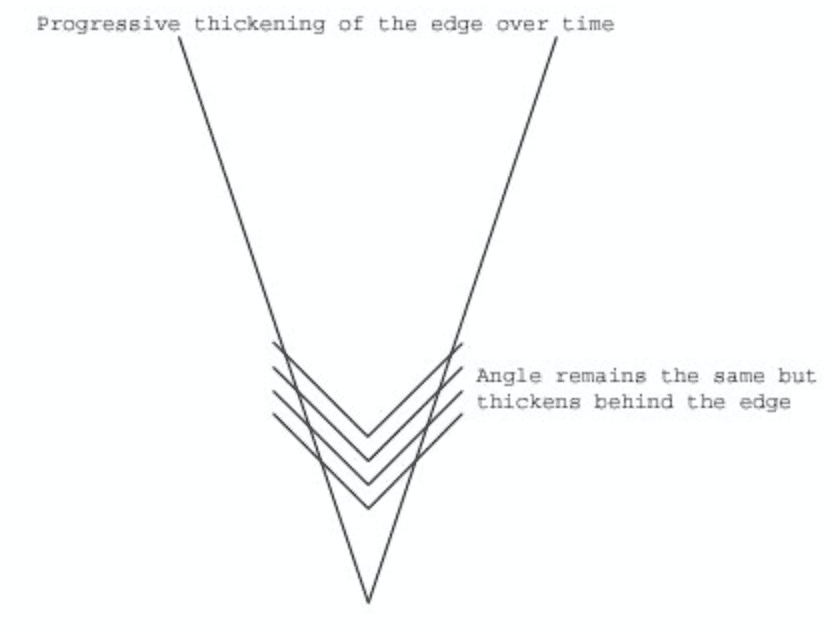- Joined
- Jul 9, 2021
- Messages
- 4
Hello everyone, I just made an account on their forum for this question, So I hope you guys can help me out.
Just yesterday I received a KAN Core 8-inch Chef Knife as a gift, and I gotta say I'm thrilled (even though I am aware it's not actually Japanese made, more like Japanese inspired, but that's kinda irrelevant). On the little getting started guide they provide, it says to avoid using a belt sharpening system, as they create convex edges on the blade:
About a month ago I bought a used Ken Onion Work Sharp Sharpener to sharpen the cheap knives I use on a daily basis, and I gotta say, to an inexperienced individual it worked great.
Before purchasing it, I tried my hand at a pebble brand whetstone, and spent quite a few hours trying to get good at it, and maintain a constant angle and pressure and whatnot, but I never really could do it all that well or all that consistently, I would always end up with sections of my knife being sharper than others. It was always odd to me that all the professionals swear by this incredibly artistic system. I am an engineering student, and I can't escape the fact that if whetstone sharpening requires so much hand precision and skill, it can't really be an ideal solution to knife sharpening, which is what drew me into the work sharp system I bought. Is there any actual risk of ruining my new expensive knife on it? I understand that the heat generated by an actual bench grinder or some other high-power grinding tool can ruin the temper on the blade, but the Work Sharp system can spin at a super slow RPM and you are supposed to move the knife through it pretty quickly, I can't imagine it would have enough time to generate enough heat to do any real damage.
What I am more concerned about is altering the geometry. Belt sharpening by its very nature will create a convex edge. Is this a bad thing? will changing the geometry of my knife "ruin it"? From my perspective, I can't see this being any more prone to geometry changing than just being bad at using a whetstone, so I'm not really sure, I'm very new to the knife enthusiast scene, and wanted to make sure I can actually take care of this knife, (and avoid buying more whetstones cause I can't seem to be any good at them)
Just yesterday I received a KAN Core 8-inch Chef Knife as a gift, and I gotta say I'm thrilled (even though I am aware it's not actually Japanese made, more like Japanese inspired, but that's kinda irrelevant). On the little getting started guide they provide, it says to avoid using a belt sharpening system, as they create convex edges on the blade:
About a month ago I bought a used Ken Onion Work Sharp Sharpener to sharpen the cheap knives I use on a daily basis, and I gotta say, to an inexperienced individual it worked great.
Before purchasing it, I tried my hand at a pebble brand whetstone, and spent quite a few hours trying to get good at it, and maintain a constant angle and pressure and whatnot, but I never really could do it all that well or all that consistently, I would always end up with sections of my knife being sharper than others. It was always odd to me that all the professionals swear by this incredibly artistic system. I am an engineering student, and I can't escape the fact that if whetstone sharpening requires so much hand precision and skill, it can't really be an ideal solution to knife sharpening, which is what drew me into the work sharp system I bought. Is there any actual risk of ruining my new expensive knife on it? I understand that the heat generated by an actual bench grinder or some other high-power grinding tool can ruin the temper on the blade, but the Work Sharp system can spin at a super slow RPM and you are supposed to move the knife through it pretty quickly, I can't imagine it would have enough time to generate enough heat to do any real damage.
What I am more concerned about is altering the geometry. Belt sharpening by its very nature will create a convex edge. Is this a bad thing? will changing the geometry of my knife "ruin it"? From my perspective, I can't see this being any more prone to geometry changing than just being bad at using a whetstone, so I'm not really sure, I'm very new to the knife enthusiast scene, and wanted to make sure I can actually take care of this knife, (and avoid buying more whetstones cause I can't seem to be any good at them)


